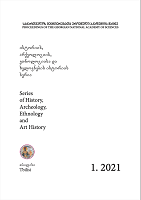კულტურისა და ხელოვნების ზოგიერთი საკითხი XIX საუკუნის გურიაში (ალეგრობა)
SOME ISSUES OF CULTURAL LIFE IN GURIA IN THE XIX CENTURY (ALEGROBA)
Author(s): IRMA GHONGHADZESubject(s): Theatre, Dance, Performing Arts, Cultural history, Customs / Folklore, Ethnohistory, Cultural Anthropology / Ethnology, Culture and social structure , Sociology of Culture, 19th Century, History of Art
Published by: საქართველოს მეცნიერებათა ეროვნული აკადემიის გამომცემლობა
Keywords: Chant; Gurians; Ozurgeti; Periodical Press;
Summary/Abstract: Guria with all its culture, morals and customs and only its characteristic mosaic is an interesting region for everyone. It is said that the character of the nation is expressed in its nationaldance and song, and Gurian folklore furthermore emphasizes mosaic character of the Gurians. Gurian folklore is distinguished. Gurian “Krimanchuli” is considered to be the peak of Georgian polyphony. Anzor Erkomaishvili compared it to a swallows’ flutter. Gurian “Kanuri” or “Naduri” are also well-known. From the old Gurian dances are known: “Partsakuku”, “Kalmakhoba”, “Leaf dance” and others. “Partsakuku” is a mass dance of war-winning horsemen and is performed with women. It is known the three-storey “Partsakuku” in Guria. Gurians and in particular the intelligentsia of the whole Rioni district to raise the level of education and culture used such means as – sport spectacles, alleys, donations, beauty prize draws. Progressive-minded intelligentsia knew perfectly well how great the role of culture was in educating the society, it is therefore noteworthy that Lanchkhuti has become one of the important hotbeds of theatrical culture. Guria is an interesting place for everyone with all its culture, morals and only its characteristic color. It is said that the character of the nation is seen in its national dance and song, and Gurian folklore further emphasizes the already colorful nature of the Gurians. Gurian folklore is distinguished. Gurian “Krimanchuli” is considered to be the peak of Georgian polyphony. Anzor Erkomaishvili compared it to the flight of swallows. Gurian “Khanuri” or “Naduri” is also known. From the old Gurian dances it is known: “Partsakuku”, “Kalmakhoba”, “Dancing with leaves” etc. “Partsakuku” is a mass dance of war-winning horsemen and is performed with women. They knew the three-storey “Partsakuku” in Guria. “Alegroba” is a holiday spread in Guria centuries ago. “Allegro” is an Italian word and means “fast music”. It is true that the Gurians can not be compared to the Italians in terms of music, but so many Italians visited Guria, suddenly theycopied the spectaclefrom them and one day they organized a Gurian-Italian celebration, which was called “Alegroba” by the guests.
- Issue Year: 2021
- Issue No: 1
- Page Range: 209-219
- Page Count: 11
- Language: Georgian

